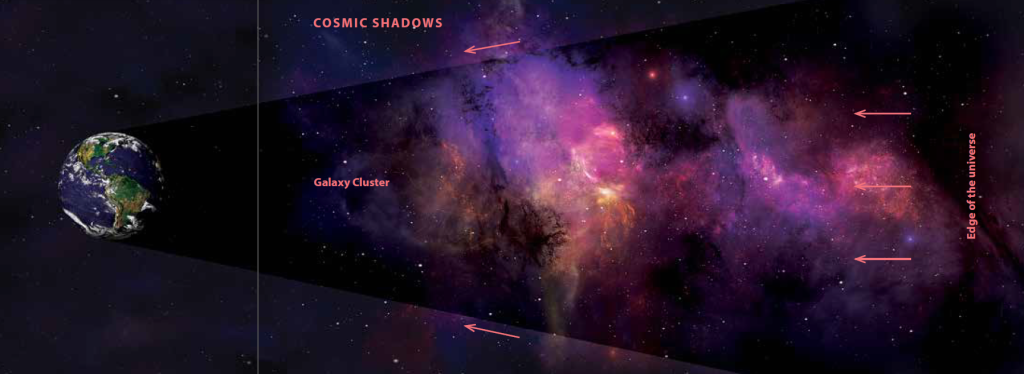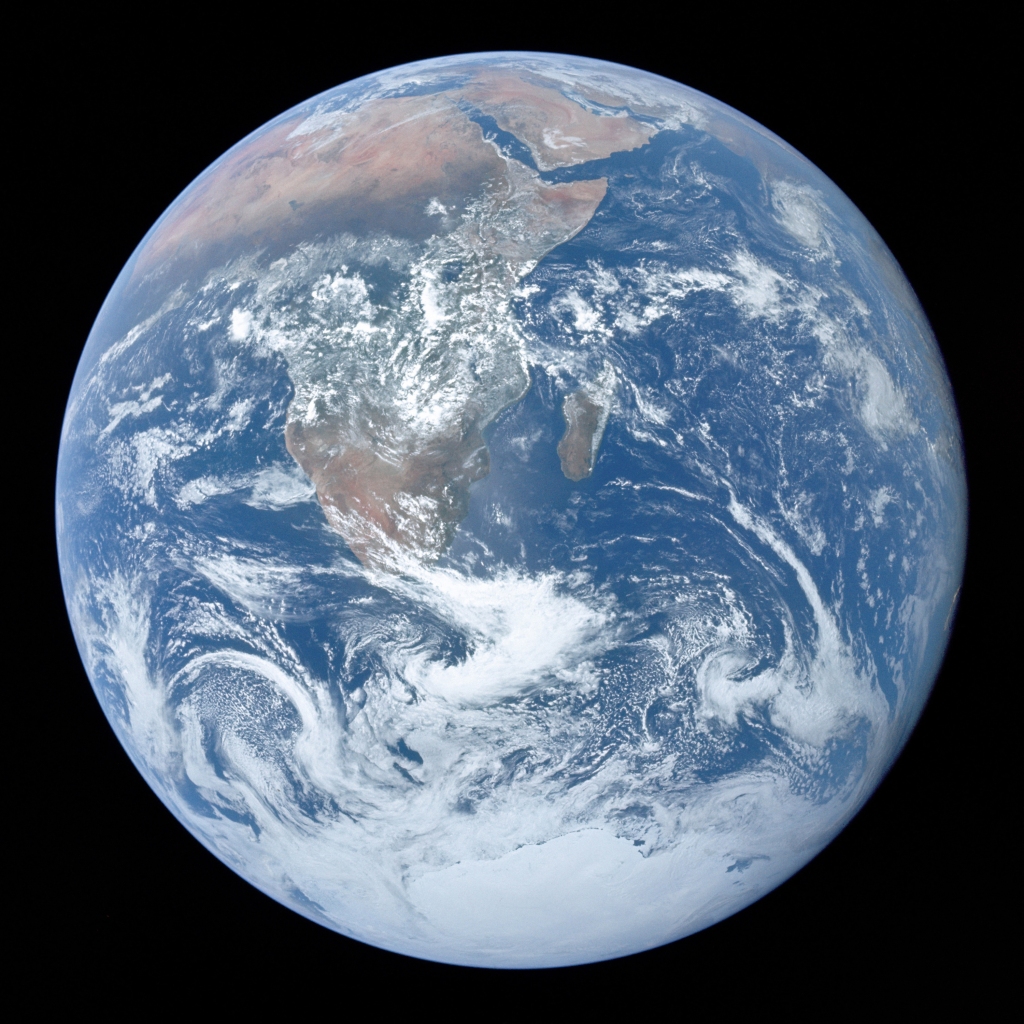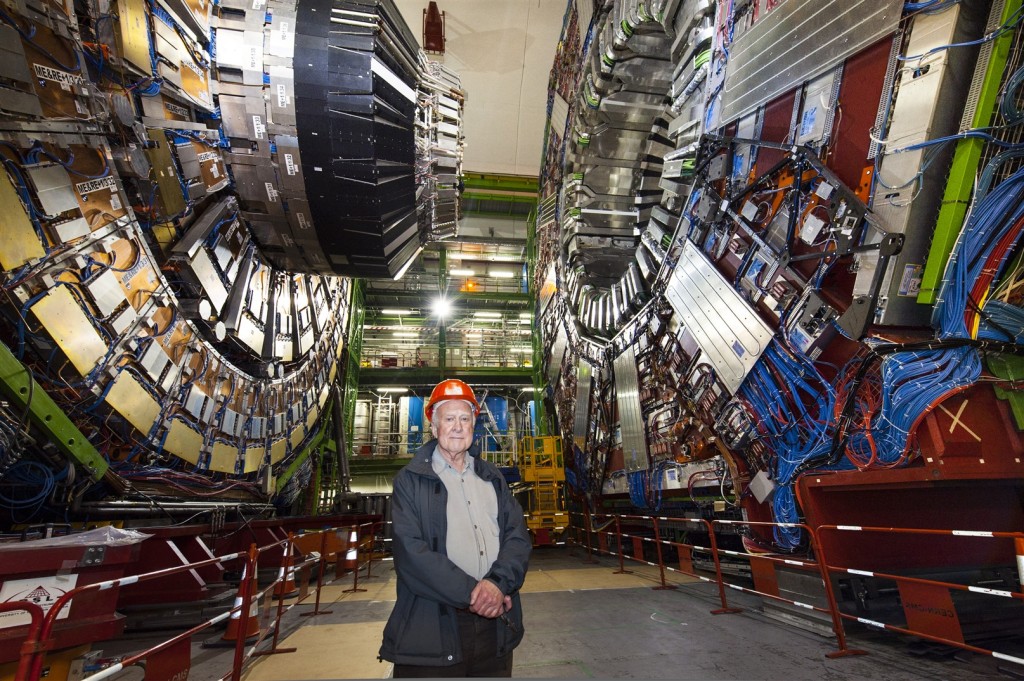If the big bang were true, the light from the fireball should cast shadows in the foreground of all galaxy clusters.
Published in Creation magazine 37(1):50-51, 2015.
Update (1/3/2018) I first have made this argument in 2006 based on the work of Prof. Lieu and others. If the big bang were true, the light from the fireball should cast a shadow in the foreground of all galaxy clusters as illustrated below. However new research (Xiao, W., Chen, C., Zhang, B., Wu, Y., and Dai, M., Sunyaev–Zel’dovich effect or not? Detecting the main foreground effect of most galaxy clusters, MNRASL 432, L41–L45, 2013) has thrown this conclusion into doubt. Prof. Lieu at the time wrote “Either it [the microwave background] isn’t coming from behind the clusters, which means the Big Bang is blown away, or … there is something else going on.” As it turns out that “something else” is contamination of the expected shadowing by radio emissions from the galaxy clusters themselves.
Without anything to contradict this new result, and the analysis seems strong, one must entertain the possibility that the anomaly first found by Lieu et al in 2006 has been adequately explained. The problem of course is that astrophysics is not exactly operational science. At best this no-shadow argument is now equivocal and hence I suggest that it may no longer be used as an argument against the big bang hypothesis.
One of the alleged ‘proofs’ of the big bang model of origins is said to be the Cosmic Microwave Background (CMB). The radiation was discovered in 1964 by Penzias and Wilson for which they won the Nobel prize in physics. Soon after their discovery, it was claimed that this radiation is the ‘afterglow’ of the original ‘explosion’ or fireball of the big bang. Since the time at which the radiation, which started as heat, was emitted from the fireball, the universe has allegedly expanded by a factor of 1,100. Thus, that ‘afterglow’ radiation has ‘cooled down’ to much longer wavelengths (‘stretched’ from the infrared to the microwave portion of the spectrum).1 These are detected by microwave telescopes today.

According to theory, the big bang fireball should be the most distant light source of all. Thus all galaxy clusters would be in the foreground of this source. Therefore all CMB radiation must pass the intervening galaxy clusters between the source and the observer, here on earth. This radiation passes through the inter-galactic medium, between the galaxies in the clusters, and is scattered by electrons, through inverse Compton scattering,2 now known as the Sunyaev–Zel’dovich effect (SZE).3 When this happens, the path of the CMB radiation is interrupted and distorted.
In 2006 it was reported and published in the Astrophysical Journal4 that indeed there is strong evidence, out to at least one degree from the cluster centre, of an anomalous cooling effect. The anomaly was that the expected shadowing effect was not found when compared with what was expected from the SZE.5 The study looked for a shadow in the CMB radiation cast in the foreground of galaxy clusters, which must be closer to us than the alleged source of the background radiation. The study involved 31 galaxy clusters with a net result indicating that on average no systematic shadows were detected. In fact, the question was asked, Why are the clusters so relatively hot? Is there an additional source of emission that cancels out the expected shadow?

The results were reported in ScienceDaily.com under the headline “Big Bang’s Afterglow Fails Intergalactic ‘Shadow’ Test”.6 A team of University of Alabama Huntsville scientists, led by Dr Richard Lieu, used data from NASA’s Wilkinson Microwave Anisotropy Probe (WMAP) to scan the cosmic microwave background for shadows. Previous groups have made these sorts of studies but this was the first with WMAP data. Remember WMAP was designed specifically to detect the signature or echoes of the big bang. But …
“Either it (the microwave background) isn’t coming from behind the clusters, which means the Big Bang is blown away, or … there is something else going on,”
said Lieu.
More woes for a big bang history of the universe. Another problem for those who hang their Christian apologetics on the beliefs of ‘modern science’.7,8 Some of those who erroneously believe in big bang ‘creation’ tried to refute this claim but failed to even understand the basic physics involved.9
The interpretation of the observational evidence presented by Lieu et al. seems to be still unrefuted. This means that the source of the CMB must be local and not from the big bang. However, the worldview which incorporates belief in the big bang is dominant, and the SZE effect is now used to detect the presence of galaxy clusters. They are looked for in the CMB data from the latest Planck satellite operated by ESA. But if the SZE only yields a cooling effect in 25% of clusters, as was found in the Lieu et al. (2006) study, wouldn’t that mean they are going to miss detecting 75% of the clusters, all because of an erroneous worldview?
Lieu’s words resonate here:
“There is something else going on!”
Reference and notes
- In standard big bang cosmology, the big bang produced lots of protons and electrons, forming a plasma where the charged particles would be opaque to electromagnetic radiation. After about 380,000 years, or a redshift (z) of 1,100, this plasma cooled enough to condense into hydrogen atoms, at around 3000 K (~2700°C, 5000°F). This would be transparent to electromagnetic radiation, which would be mostly infrared at that temperature (peaking at 966 nm). The current CMB is supposed to be the strongly redshifted afterglow, as the universe has cooled by a factor of 1,100.
- Compton scattering means that a photon collides with an electron, imparting some energy to the electron which recoils, while another photon carrying the remaining energy (so a lower frequency) is emitted at an angle from the original so momentum is conserved. Inverse Compton scattering means that a very energetic electron loses energy, so the scattered photon has a higher energy and thus higher frequency.
- Sunyaev [Сюня́ев], R.A. and Zel’dovich [Зельдо́вич], Y.B., Small-scale fluctuations of relic radiation, Astrophysics and Space Science 7:3–19, 1970.
- Lieu, R., Mittaz, J.P.D. and Shuang-Nan Zhang, The Sunyaev–Zel’dovich effect in a sample of 31 clusters: A comparison between the x-ray predicted and WMAP observed Cosmic Microwave Background temperature decrement, Astrophysical J. 648:176–199, 1 September 2006.
- However the expected cooling due to the shadowing effect of the galaxy cluster was found to be deficient by 100 μK. For example it might have been expected that the foreground cluster would cast a 150 μK shadow (i.e. would be cooler by this amount) but only 50 μK was observed.
- Big Bang’s Afterglow Fails Intergalactic ‘Shadow’ Test, sciencedaily.com/releases/2006/09/060905104549.htm, 12 September 2006.
- Lerner, E., Bucking the big bang, New Scientist 182(2448 20, 22 May 2004.
- Wieland, C., Secular scientists blast the big bang: What now for naïve apologetics? Creation 27(2):23–25, 2005; creation.com/big-bang-blast.
- Hartnett, J.G., The big bang is not a Reason to Believe!, creation.com/big-bang-not-a-reason, 20 May 2014.






14 responses to “‘Light from the big bang’ casts no shadows”
So what happened after 2006? Why do mainstream scientists still apparently subscribe to the Big Bang? Is the theory still supported by other evidence?
LikeLike
Though Lieu et al. (2006) research was published in the leading astrophysics journal Astrophysical Journal its findings seem to have been ignored since 2006. That is not an uncommon practice for evidence that does not fit in with the ruling paradigm. Another line of evidence that has not been refuted nor explained within the standard big bang LCDM cosmology (though some have tried) is the lack of time dilation within quasars.
(excerpted from my article Does observational evidence indicate the universe is expanding?—part 1: the case for time dilation)
The point of this is that there exists lines of evidence that are inconsistent with the standard big bang origin of the universe. Just because something is ignored does not make it less valuable.
But of course mainstream scientists still subscribe to the big bang. It is part of their worldview–their belief system. See WHY IS A 6000-YEAR-OLD UNIVERSE SO HARD TO BELIEVE? . And yes, you can always find evidence to support the big bang theory; it all depends on what you will accept as evidence. If the evidence uses unobservable stuff like dark energy, dark matter, dark radiation to get the theory to fit the evidence, then you probably can never refute it. See BIG BANG FUDGE FACTORS and DARK RADIATION IN BIG BANG COSMOLOGY. It is very plastic. But really that is the problem with cosmology; it just is not science. See COSMOLOGY IS NOT SCIENCE!
LikeLike
If the Big Bang is correct I doubt it could ever be fitted to a 6,000 year old universe.
LikeLike
I agree. There are two completely opposing paradigms here: both are subject to untestable constraints. Those constraints make it scientifically impossible to determine which is the true history of the universe. The big bang has evolved out of the need to explain the universe naturalistically which also has meant a 14 billion-year timescale. The biblical creation account gives only a 6000-year timescale but that does not preclude a vast distance scale as some might imagine. No internally consistent biblical creationist would want to try to fit the big bang into a 6000-year timescale. Christians who accept the big bang origin of the universe, like William Lane Craig, accept all that goes with the big bang, 14 billion years and all. But that approach is a rejection of the authority of scripture.
LikeLike
Doesn’t the standard paradigm claim that we just live on the 3-D surface of a 4-D universe (i.e. not counting time as a dimension)–that we are like spots pasted onto an expanding balloon? In that case, would there be any favored direction for the fireball, and would we expect to see shadows?
LikeLike
Since the big bang universe is not only isotropic but also homogeneous it should be that any observer anywhere in 3D space should observe the radiation from the alleged fireball as coming from the most distant source. So for all observers at all epochs and all spatial points shadows should be observed in the foreground of all clusters. Another way of thinking about this is this. Because of the passage of time and the fireball was an alleged event in the most distant past the radiation we observe should be coming from the horizon. Any radiation within the horizon has already past us. You could think of that horizon expanding out at the speed of light. It is therefore expected to be isotropic and the most distant source.
LikeLike
Maps of the CMB show a non-uniform distribution. So, it’s not truly isotropic–right? Isn’t that the basis of the Horizon problem?
LikeLike
It is essentially isotropic. The anisotropies are on the scale of about 50 to 70 microK variations away from the smooth uniform 2.72548±0.00057 K temperature. This uniformity across the sky is the reason for the Horizon problem. Because nearly all regions at the horizon have been out of causal contact with each other for the alleged past 14 billion years, and they represent points on the last scattering surface of the big bang fireball, which cannot have been in causal contact with each other, so how is it we observe in the CMB that they are at the same temperature? The alleged solution is that those regions must be representative of the state of the very early universe when it was much smaller and in thermal equilibrium but inflation (an unproveable conjecture) rapidly expanded them out of causal contact with each other, thus preserving their former uniform state. Hence it is sometimes called ‘fossil radiation’. Read BIG BANG HAS A LIGHT-TRAVEL-TIME PROBLEM.
LikeLike
If the BB fireball did cast shadows, then wouldn’t the shadows all point to some central point of the universe, proving that it does have a center and an edge? If you were inside a spherical room where the spherical wall glows, then wouldn’t the shadows cast by all the objects in the room be cast toward the center of the sphere? Are we considering real shadows, or simply regions of space where certain areas of the fireball’s afterglow are obscured from view by intervening matter? Would the shadows (if they existed) be a real, fixed phenomenon, independent of an observer’s location, or a relativistic effect that does depend on the observer’s location?
LikeLike
All observers at any spatial point and any epoch should see shadows cast in their foreground. This is the main point of the cosmological principle, which is an essential underpinning of the Friedmann–Lemaître solution of Einstein’s field equations that we call big bang cosmology today. In that is the idea of homogeneity, so that no matter where you hypothetically might be observing from, at the same epoch, you would see the same thing. Hence no centre, no special place, and not edge to the Universe.
LikeLike
On further reflection, I guess your point is that the galaxies don’t seem to obscure the CMBR. You could be anywhere relative to a galaxy or galaxy cluster, and the CMBR emitted from behind the galaxy or cluster would still be visible and having the same magnitude as from any other direction. Is that correct? In that case, the CMBR would appear to be more of a foreground effect than a background effect. Perhaps it should be called the CMFR?
LikeLike
Yes, by there not being a systematic shadowing effect, it implies the source of the shadows seen in 25% of clusters is behind those clusters but in front or on the side of other clusters. So the source of the CMB radiation is not the most distant. Maybe we shouldn’t call it CMFR but Cosmic Microwave Radiation (CMR), since its source could be from a vicinity much more local than the BB fireball.
LikeLike
The CMB radiation can be explained using replicable physics, however the line of evidence from the CMB ‘ember’ radiation to such replicable physics contains about a dozen elements. Further this requires the setting aside all the old mathematical assumptions made between 1915 to 1935 and then adding real physical experiments and discoveries since 1935. [web address deleted]
LikeLike
Charles, from what I understand you might be saying I don’t agree. I don’t know what ’ember’ radiation is nor replicable physics in this context. Since access to the universe to do repeatable experiments on it is not available due to both its size and the time required cosmology is not science in the usual laboratory sense. But if the CMB radiation (which is extremely well described as blackbody radiation) is from the fireball of the big bang, it would always be the most distant source in the universe and hence always should cast foreground shadows. It does not.
LikeLike